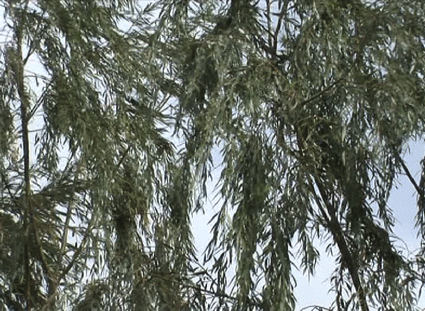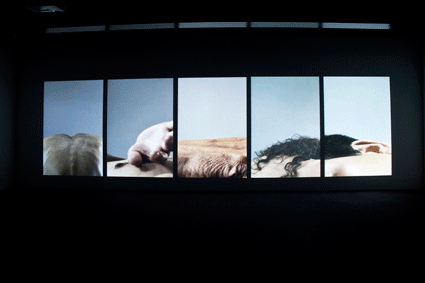Time-shifting landscapes
Greg Hooper: Wang Gongxin, MAAP Space

Wang Gongxin, Tonight Maybe Have Wind (2006), video stills
Down an alley between the small-scale old industrials of Fortitude Valley and into the new location of MAAP (Media Art Asia Pacific). Starting 15 years ago curating Asian-Pacific multimedia, Kim Machan’s MAAP has expanded into a gallery space, media resource centre and online repository of back catalogue(s) and other writings. A happy extension from curator to host.
The new space opened late last year with a solo show by Zhang Peili, who pretty much initiated video art in China with his 1988 video performance of repeatedly smashing a mirror, gluing it back together, smashing it again, regluing etc etc. Now MAAP is showing the other major pioneer of video art in China, Wang Gongxin, who installed and exhibited The Sky of Brooklyn—Digging a hole in Beijing in his own home in 1995, the first time video art was shown in Beijing.
Two works from Gongxin. The unfortunately named Tonight Maybe Have Wind (2006) is there as you enter—flat TV-sized monitor on the wall, a close-ish shot of swaying branches running in a repeated pattern of super-fast and ultra slow. Four minutes sped up and slowed down in such a way as to keep the ‘actual’ total duration unchanged. And there’s a subtle change synced to the image speed—the colour drops out to black and white, then slowly returns. Seems a bit of a formalist exercise on the representation of time through tech and I find myself struggling to get much of an aesthetic or intellectual buzz. I think about subjective time and attentional focus, the adaptive function of colour vision for an ape wanting to munch the ripest fruit and the freshest leaves but, nup, nothing. Ah well.

Wang Gongxin, Basic Colour (2010), installation view
photo Emily Nelson
Wang Gongxin, Basic Colour (2010), installation view
The other piece, Basic Colour (2010), provides an occasion for contemplation in formal simplicity and slowly changing fields of colour and sound. This work is much larger, five doorway-sized videos projected in a line onto a single wall. On the bottom third or so of each is a closeup of a body part—the back onto the shoulders, a hand reaching toward us, the side of another hand, the nape of the neck, a head on its side. Images are in sharp focus, abstracted by their size. Starts au naturel then pigment begins to fall onto each of the body parts—black on the shoulders, blue to the reaching hand, red to the side, yellow to the nape and white to the head. I cringe watching the ear slowly fill with white pigment. The sound is like rice falling onto card, a population of coherent noise emerging from thousands of individual grains. Then the pigment stops and water begins to softly fall and bead with the pigment. The beads join together, trickles form and colour runs down the body and away. And in moving from dry pigment to dripping water the sound slowly changes from falling rice to falling rain. Or maybe I’m imagining that change, the dominance of the visual forcing consistency between unchanging sound and changing image.
The body as land goes back forever. There are bodies of water, breast-named hills and bodies marked with ochre and ash. Gongxin shows that tradition and washes it away. The video loops and the tradition replays.
Wang Gongxin, MAAP Space, Fortitude Valley, Brisbane, March 22-May 3; maap.org.au; wanggongxin.com
Also check out http://www.maap.org.au/publications/, the recently launched online archive featuring 15-years of MAAP publications.
This article originally appeared as part of RT’s Online e-dition May 15, 2013
RealTime issue #115 June-July 2013 pg. 28






